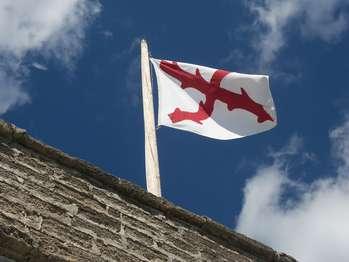Last updated: April 9, 2021
Place
The Spanish Flag

Historical/Interpretive Information/Exhibits
Spanish naval ships began to fly this flag in the early 1500s in honor of their king. In those days, the flag of a country was actually the flag of the ruling house. Eventually, the army also began to fly this flag, and it came to represent Spain. As Spain's power spread to the New World and across the Pacific to the Philippines, this was the flag carried by ships and flown over the fortresses which guarded Spain's possessions. Thus, it is sometimes referred to as the Spanish Colonial Flag.
The flag which flies over Fort Matanzas is commonly called "St. Andrew's cross" because tradition says that Andrew the Disciple was crucified on a cross shaped like that. The story is that the branches were roughly hacked off two small trees, and the trees were tied together to make the cross. The jagged edges of the cross on the Spanish flag represent these trees with the branched lopped off.
Since the flags of Ireland and Scotland (and the flag of Great Britain incorporating the cross of Scotland) are also St. Andrew's crosses, when speaking of the Spanish flag, this design (the red saltire raguly on a white field) is best called the Burgundian Cross.
Queen Isabella and King Ferdinand, who sponsored Columbus' voyages to the New World, used the medieval flag with the red and gold quartered lions and castles which represented the united Spain of Leon and Castile. However, since they did not have a son live to succeed them, the Spanish Crown went to the son of their oldest daughter Juana (Juana the Mad) who was married to Philip, Duke of Burgundy (Philip the Handsome). The red saltire was his family symbol since Andrew was the patron saint of Burgundy. White was the distinctive color of French Royalty, and Burgundy was a French state.
In 1506 Philip came to rule Spain as Philip I as regent to his young son Charles. Charles also adopted this flag when he became Charles I of Spain (1516-1556). He was also Charles V of the Holy Roman Empire, probably the most powerful man in Europe at that time.
In 1785, however, under King Charles III, the red and gold striped flag with the simple crest of Castile and Leon became the naval ensign of Spain and by 1793 was also adopted by the forts and other military buildings, but it did not become the Spanish regimental colors until 1843. Since the late 1800s it has been regarded as the flag of a monarchial group in Spain called the "Carlistas".
One also sees variations to the original design. On religious occasions, the field was sometimes blue, the color of the Virgin, and images of the Virgin Mary were placed in the quarters formed by the cross. Sometimes the Spanish coat-of-arms (the quartered castles and lions) was added to the ends of the arms of the cross.
This flag is actually be square rather than rectangular. Spanish military regulations called for a square battle flag, 6 feet on a side. The colonial Spanish pie (foot) was 11 inches (as measured today), so this flag would be 66" square. Also, the jagged points all point up on both bars.
